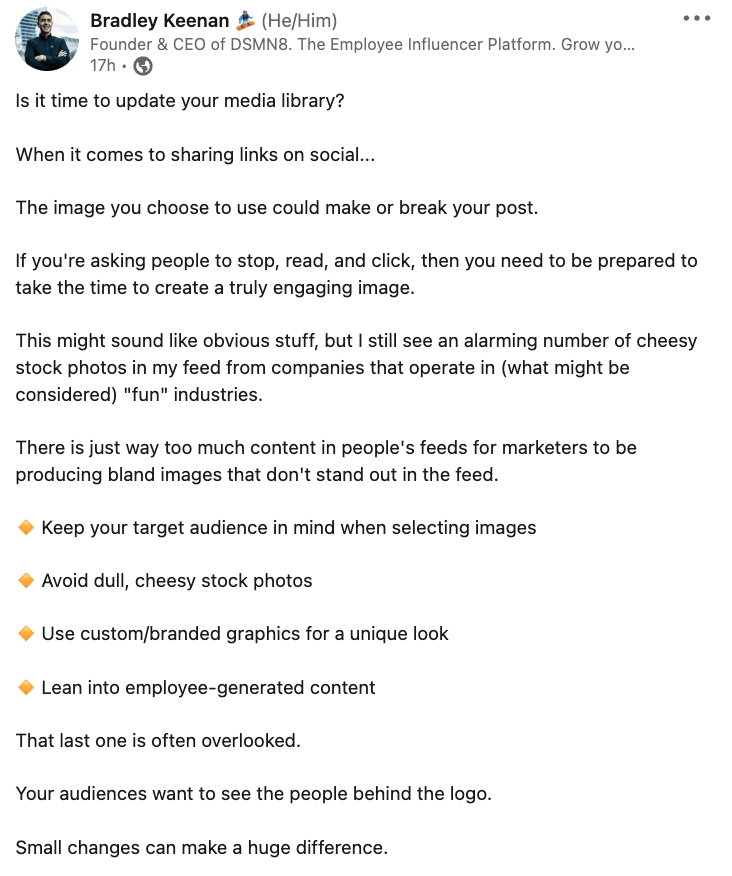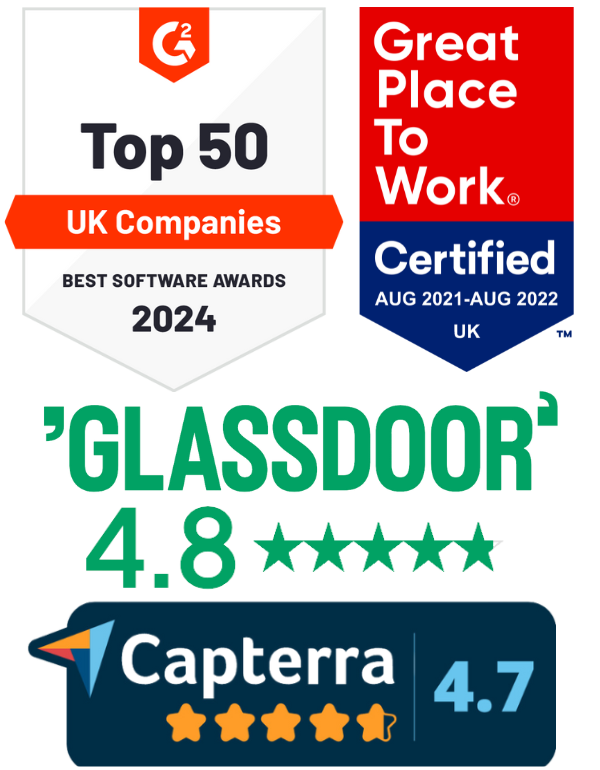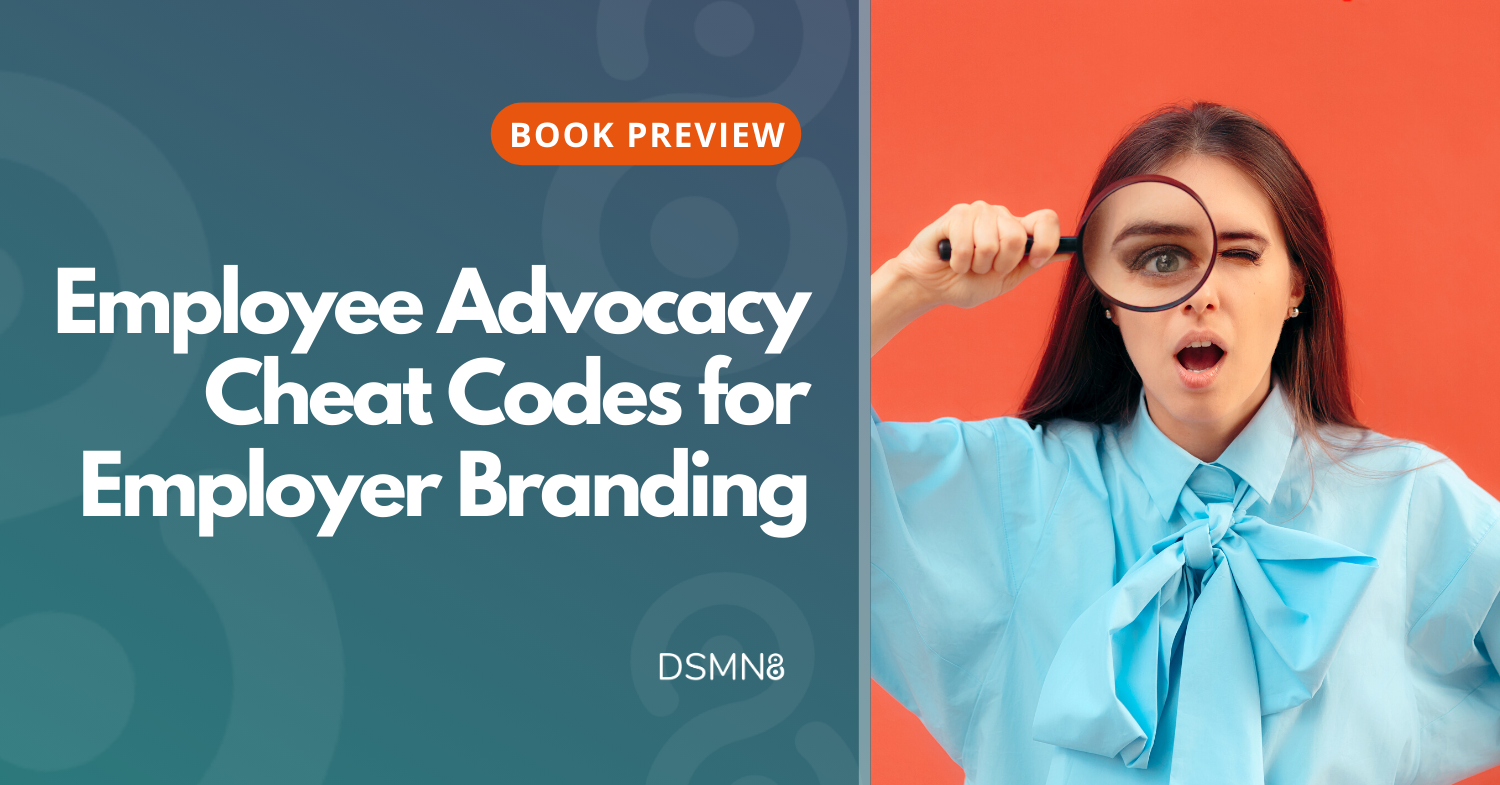
By now, you might have heard that DSMN8 co-founder and CEO, Bradley Keenan, has written a book! Employee Advocacy: 101 Cheat Codes is all about how to start and scale your employee advocacy program.
Bradley provides his expert insights from years of experience, condensed into 101 bite-sized chapters, or as he calls them, ‘Cheat Codes’. The idea is that you don’t have to read this book cover-to-cover. You can flip to any page, and discover a valuable employee advocacy insight or strategy.
Today we’re sharing some cheat codes from the book, for those working in employer branding roles, or looking to improve their employer brand generally this year.
Employee advocacy is a game-changer for your employer brand. According to LinkedIn, companies with a ‘high number of employees sharing high-quality content and thought leadership’ are 58% more likely to attract talent.
From showcasing company culture with authentic employee-generated content to positioning your executives as industry thought leaders, employee advocacy supports your talent acquisition efforts, and increases employee engagement.
Whether you’re currently using employer branding software or not, these cheat codes can be implemented.
So let’s jump into some cheat codes for employer branding, chosen from each section or ‘level’ of the book 👇
Level 1: Ready, Set, Go!
#6: Create an Advocacy-Ready Social Media Policy
Your social media policy should outline the code of online conduct you expect your employees to adhere to. This includes the behavior you expect from them when sharing anything online, work-related or not.
If you’re as old as me, you’ll likely remember social media policies that read, in essence, “don’t ever share anything on social media, full stop.”
In recent years, companies have come to realize that having employees actively posting and engaging on social media is hugely advantageous. This evolution has led to policies becoming far more inclusive and encouraging.
The goal of your social media policy should be to guide and encourage employees, not police them. If yours is a big list of things not to do, it’s going to make them too scared to post anything.
Instead, align your policy with business goals. Present it as a tool to empower your employees, enabling them to use social media to help the company meet those goals.
A clear policy that states what’s completely off limits, while allowing for authentic posting, will both alleviate employee worries and help you avoid a PR nightmare.
It’s imperative to make sure employees are aware of your new social media policy. They need to know that times have changed. Give copies to new starters as soon as they join.
Remember: your Social Media Policy should enable your team to use social media to your company’s benefit, not create barriers to stop them.
Use my social media policy template to get started, and have a read of our recommended social media guidelines.
Use my Ideal Advocates Worksheet to discover the advocates you should onboard to your advocacy program first.

Listen to the podcast episode to find out more about creating personas for your advocates.
#11: Create Personas for Your Potential Advocates to Begin to Understand Them.
In sales, we talk about buying personas. It’s essentially creating a fictional representation of an ideal customer in order to better understand their needs.
So apply that concept to employee advocacy. What are your potential advocates like?
To get you started, I’ve built 4 personas based on the types of people that make good advocates. Understanding their different motivations, challenges, and content preferences before launching will help you shape your program to drive advocate engagement.
1. The Seller
This is the most obvious one, but they aren’t necessarily a salesperson. It’s anyone in the company with quotas to reach. Their main challenge is time. They’re under pressure to hit their numbers. Their motivation to join an advocacy program would be to exceed targets by positioning themselves as thought leaders. The content that resonates with this person helps them make sales. It’ll be things like social proof, case studies, product updates, and industry news.
2. The Leader
The CEO, divisional heads, and sales leaders all have an external responsibility to show what’s going on in the company, and an internal responsibility to lead employees. Their challenge is engaging the workforce. They’re time-poor, and although social media may not be their number one focus, their motivation is to be seen as industry experts while broadcasting company communications, internally and externally. The content that will work for them will be customer success stories, company news (acquisitions, senior leader appointments, mergers), case studies, and financials.
3. The Champion
This is someone who loves where they work. They support the company mission, believe in it, and want to be an ambassador. Their challenge is internal politics. For example, they might not go on LinkedIn and write content about their company, out of fear of stepping on marketing’s toes. They’re afraid of getting it wrong. They also don’t want their employer to think they’re looking for a job by building their personal brand. Their motivation is simple: they enjoy being a cheerleader for the company. The content they lean towards is positive PR, awards, and company culture.
4. The Ambitious
These people are looking to advance their career by networking and building their personal brand. Whether they believe in the company mission or not is irrelevant. They know that sharing content makes them more visible, both internally and externally. It makes them look like a team player and boosts their reputation. This person’s challenge is that they’re dependent on their digital reputation. They need content to share, and lots of it. They don’t have a content preference.
#15: A Strong Personal Brand Is Priceless. Make Sure Employees Know That!
One of the biggest reasons people don’t post on social is that they’re worried it might harm their careers. Employees worry that if they suddenly start posting, their managers and co-workers might think they’re looking for a new job.
To counter those worries, you need to promote the benefits of employees developing strong personal brands—and carry out that promotion at a company level. Encourage all your employees to share, and explain why they should. That way, they’ll feel safe and happy to do so.
You might be worried that helping your employees create their own personal brands could make them more attractive to other companies, potentially resulting in them being headhunted. But actually, employee personal branding will not only hugely benefit your business and its image, but also make it more likely to retain and attract talent.
Employees with strong personal brands have stronger relationships with their social media audiences. This results in those audience members having stronger relationships with your brand. Employees with well-developed personal brands can also become seen as thought leaders and industry experts, building further trust and kudos within their networks.
Providing content to your employees to help their personal brands flourish will be a vitally important part of your advocacy program. You’ll need your employees to feel empowered to post more about what they know. This, in turn, results in more posts about your company.
The Key Benefits of Personal Branding for Employees
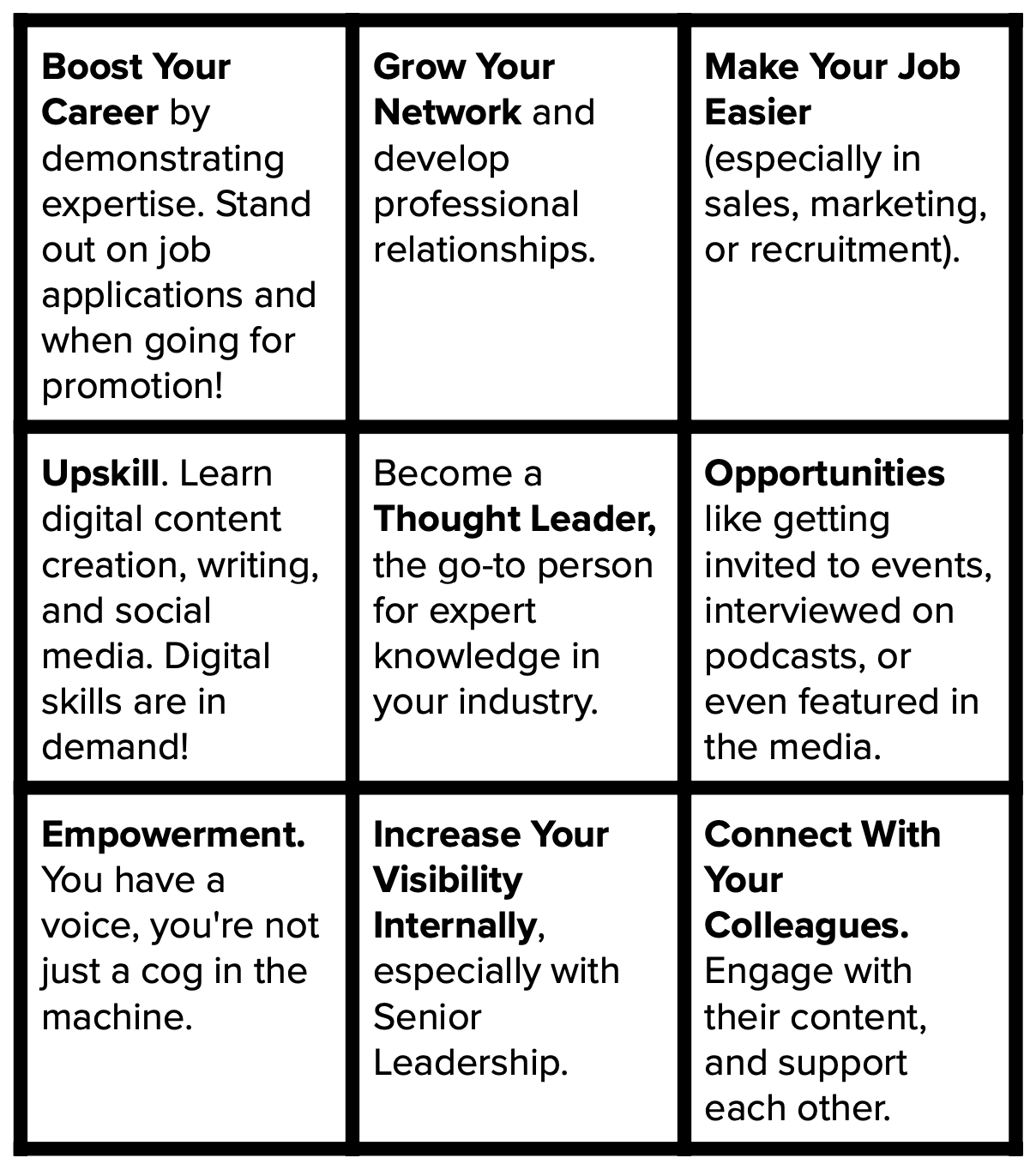
Listen to the podcast episode for more on how advocacy supports career journeys.
Level 2: Select Your Characters
“A company is people… employees want to know… am I being listened to or am I a cog in the wheel? People really need to feel wanted.”
RICHARD BRANSON, BRITISH BUSINESS MAGNATE, AND FOUNDER OF VIRGIN GROUP.
Listen to the podcast episode about creating an effective feedback loop for your advocacy program.
#26: Company Culture Is Everything. Employees That Feel Valued Will Naturally Become Advocates.
Company culture is the foundation of employee advocacy.
Employees that feel valued are much more likely to naturally advocate for your company, and want to join your program!
To put it bluntly, employee advocacy cannot exist without a good company culture. Forcing employees to post positively about your brand on social media when they don’t want to isn’t the way to go. The content simply won’t come across as authentic, and employees will begrudge you for making them do it.
A thriving company culture encourages collaboration, creativity, and an atmosphere of trust. You’ll want honest feedback on your advocacy program content in order to improve it, and you’ll only get this in an environment where employees feel safe to voice their opinions.
Focus on improving your company culture, and you’ll see better results from your program.
Level 3: A Day In The Life
#40: Promote Job Ads Without Spending a Dime.
People know people who know people.
Your advocates are highly likely to be connected to people who work in the same fields they do… who are also highly likely to be connected to other people who also work in those same fields… As a result, your employee advocacy program could be extremely useful for attracting new talent.
You might want to hire new engineers, for example. If so, encouraging your engineer advocates to post about the benefits of working for your company can really pay dividends, attracting potential new employees at a fraction of the cost.
But you shouldn’t expect simply blasting social media with job ads to bear fruit. Talent acquisition through employee advocacy needs to be delicately balanced with content promoting your company as a desirable workplace.
It doesn’t need to be complicated. Content that features a tour of your offices, existing employees discussing their experiences, or pictures from team away days will all help provide that balance. Potential candidates who’ve been primed by your advocates’ posts are far more likely to hit the ‘apply’ button on your job ads.
“We publish our job advertisements on relevant platforms and also directly on LinkedIn. However, we also use our employees because they have the right candidates in their contacts and a job suggestion from a well-known person is more credible than an advertisement”
MARIJANA SLADIC, DIGITAL CONSULTANT, SWISS POST.

Listen to the podcast episode to find out more about the differences between internal comms and employee advocacy.
#42: Internal Comms and Employee Advocacy Are Not the Same.
Yes, internal communications will always be inherently linked to your employee advocacy program. They’ll both always involve employees and communication, but their objectives are very different.
Internal communication is almost the step before employee advocacy. Its purpose is to distribute company internal content to employees, in the hope they’ll digest it. This makes them aware of what’s going on inside their organizations, as well as enabling them to communicate and collaborate.
The purpose of an advocacy program is to encourage and empower employees to take content produced for external consumption, and amplify it using their own professional social media connections. The tone of external content is very different, as it’s designed to ultimately win new business, promote a brand, educate an industry, or find talent.
That means you’ll probably need to appoint someone from outside your internal comms department to run your advocacy program, someone with the skill set and knowledge required to create an excellent social media post. One of your internal communications workers may have that ability, but it will likely be by chance. This is because social media content creation is very different from the internal comms core competency of educating a workforce.
Your aims should be to build an employee advocacy program that serves both your company and your external audience—and to build it by working in partnership with your internal communications department. When you launch your program, it’s likely some people will be confused and take it to be an internal communications initiative. Be prepared to help them understand by highlighting the marketing elements that define employee advocacy.
To find out what impact employee advocacy has on internal communications, my team analyzed over 1,000 employee social media posts. The results were fascinating. Over 37% of interactions on social media posts containing company content came from co-workers. Using external channels as a way to reach your workforce is an added bonus of advocacy!
Level 4: Killer Content
#51: It’s Not All About You: Keep Your Content Varied
Using your employee advocacy program to communicate your sales message will probably be fine, as long as it’s done well.
Creating gated content to secure contact details, so a salesperson can immediately try to win business, is probably doing it badly.
Not everybody who looks at your content will be in a buying cycle at that point. Your program’s content should reflect that, and take the opportunity to create trust for your brand by educating the market and providing insight into your company.
You might, for instance, decide to spotlight your employees by celebrating promotions, weddings, and births. Creating educational content to enhance people’s understanding of your industry and how they might do their jobs better can also be an effective tool.
That way, when those people are looking to buy, they’ll think of your company as a trusted advisor.
I recommend that your content should be one-third company-centric, one-third employee-centric, and one-third educational content from third parties.
Think of each article of your program’s content as belonging to one of these three categories:
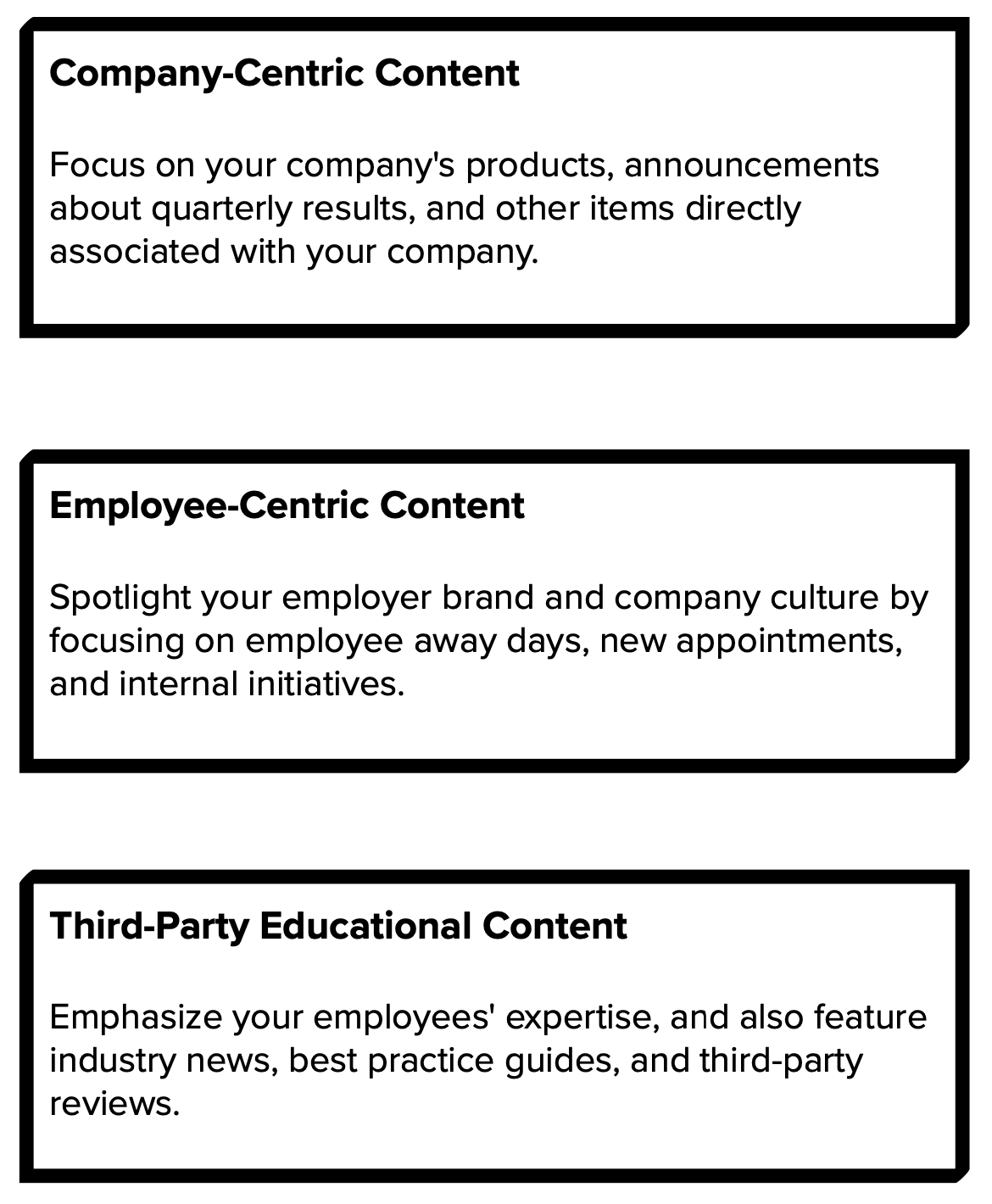
The tone and language used by your employee advocates shouldn’t sound like marketing speak, it needs to be authentic.
#61: Work in Harmony: Align Content with Marketing Campaigns
Aligning your advocacy campaigns to work with your marketing campaigns will naturally bolster the impacts of both—as long as the messaging matches up.
Of course, the tone and language used by your employee advocates shouldn’t sound like marketing speak, it needs to be authentic.
There’s no point in trying to get marketing and employee advocacy to work together if they’re focusing on entirely different areas of your business and giving different messaging. So wherever possible, the two should be thematically and strategically aligned.
For example, if your company page is focused on Pride in June for employer branding purposes, you might ask your advocates to share their own content about Pride festivals and the inclusivity of your company.
Prospective clients will follow not only your company on social media but also your employee advocates. So, you’ll need company and advocate messages to complement, rather than contradict each other.
#64: Never Scrape the Barrel: Regularly Update Your Media Library
Stock images suck. There’s nothing worse than cheesy pictures of random people in suits shaking hands. For your employee advocacy program to get flying, it’ll need a strong media library full of relatable and appealing images.
However, your social media manager can’t be everywhere at once to take photos of everything. So wherever possible, images should be gathered directly from employees. Away-day team photos, new starter’s first day photos… your program should find as much authentic image content as possible and categorize it based on key objectives.
Of course, images that don’t exist can’t be found and used, so your program should encourage your employees to take more photos. For instance, awarding a prize for the best company away-day picture would be an inexpensive way to gain access to a whole lot of images… perhaps more images than your program might be able to use. These images may be useful for showcasing your company culture on your internal communications platform, as well as for social media posts.
Photos taken by your employees will be especially useful for talent acquisition. Your advocates’ posts about upcoming employment opportunities will be far more effective if supported by authentic images.
Level 5: Executive Influence
“The ultimate gift, in our digital age, is a CEO who has the storytelling talent to capture the imagination of the markets while surrounding themselves with people who can show incremental progress against that vision each day.”
SCOTT GALLOWAY, AUTHOR OF THE FOUR: THE HIDDEN DNA OF AMAZON, APPLE, FACEBOOK, AND GOOGLE.
Listen to the podcast episode to discover key strategies for turning your CEO into a social media superstar.
#76: If Your CEO Isn’t Involved, Make It Happen
Of the 200,000+ CEOs in the US, how many can you actually name? Perhaps Elon Musk, Bill Gates, Mark Cuban…? And what do those three CEOs have in common? They’re all ubiquitous on social media.
Despite ever-increasing evidence that having a social media-active CEO helps a company close deals, attract and retain talent, and improve internal communications, many CEOs remain silent. Perhaps the potential consequences of a social media mistake feel bigger than the immediate upsides of being active.
No, not every CEO needs to be a kickass content creator.
But what message will it send to your company’s employees if even your CEO doesn’t bother to participate?
You’ll need them to be an active part of your program, setting the tone for the rest of your organization, and giving permission for employees to advocate. After all, if the CEO isn’t sharing, why would they?
As the figurehead of your organization, your CEO should be your company’s most important advocate—its thought leader. They won’t need to post every day (although it’d be great if they did), but they will need to actively increase your company’s visibility.
Level 6: Maintaining Momentum
#82: It’s a Two-Way Street: Don’t Use Your Advocates
It’s no secret that when you launch an employee advocacy program, the reason you’re doing it is to get more content visibility, and consequently reach your business goals.
That said, it’s really important that you don’t simply use your advocates as a marketing channel. This should be considered a secondary benefit.
The primary benefit is positioning your employees as experts, through sharing content on social media.
Growing their networks and building personal brands can result in opportunities like public speaking, getting invited to events, or being interviewed on a podcast. This will get their name out there and they’ll start becoming known as a person of influence, an industry expert, and a thought leader.
Those in marketing, sales, recruitment, or HR, will see even more benefits from becoming an employee advocate. It literally helps them do their jobs better.
Marketers want their content to be seen.
Sales reps want to build relationships with prospects and clients.
Recruiters and HR want to showcase company culture and reach the best talent.
Growing and maintaining a social media presence is the best way to do that.
Don’t just list the benefits, provide training and resources to help them along the way. The increased marketing reach for your company will come as a result of adding huge value to your employees.
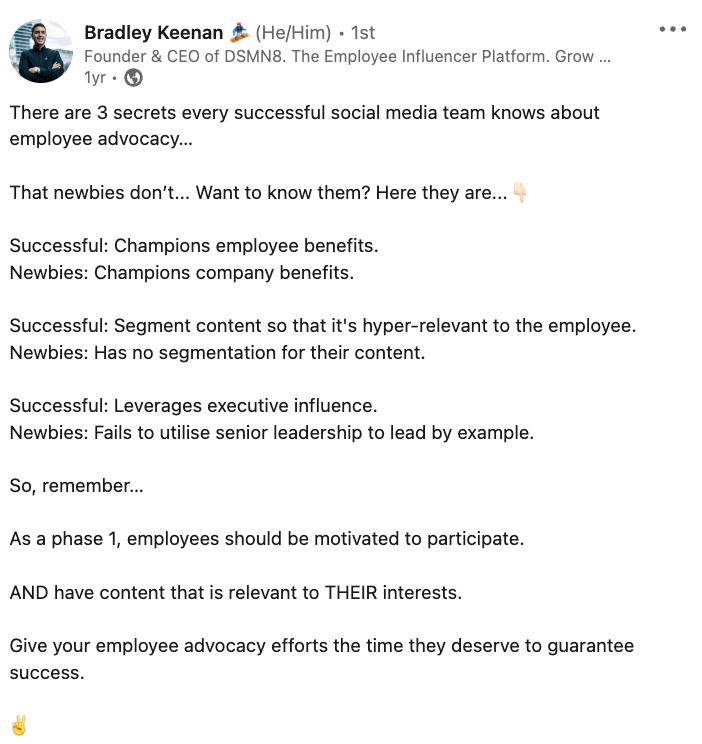
Nurture your advocates. Even if they’re not top performers, make sure every advocate knows that their efforts are appreciated.
For more tips on increasing and maintaining employee advocacy user adoption, listen to the podcast episode. Get the user adoption playbook for a 4-step strategy, an onboarding timeline, and a worksheet.
#84: Send Kudos to Random Advocates
Acknowledging the efforts of advocates who perform extraordinarily well is a no-brainer, but do not fall into the trap of only recognizing those whose activity has generated big results.
Have you ever done something as unexceptional as holding a door open for somebody, only for them to breeze past without thanking you? That’s how advocates for your business feel when they join your advocacy program but never receive feedback. Sure, they might not be setting the world alight, but as you’ve seen in the previous chapters, every contribution is valuable to your program’s success.
Genuine, heartfelt, positive feedback has a nurturing and encouraging effect on those who receive it, whether they’re 5 or 65. Its importance in the workplace should never be underestimated.
Your program leaders should give regular feedback to your company’s entire advocacy network. It shouldn’t be restricted to advocates who are topping the performance tables.
Reaching out to random advocates and those new to your program with an individual ‘well done, and thanks for being part of this’ message can really help your program keep rolling at full speed. You never know; that little pat on the back might give them a confidence boost that sends their participation soaring.
#88: Want to Generate Buzz About. Your Program? Share Success Stories, Not Statistics.
People remember stories. They don’t remember statistics.
The reality is that the average employee doesn’t care about CPCs, CPAs, or any other marketing metric that you may care about.
You need to listen to feedback from the frontline to discover the real impact of your advocacy program. It could be a simple story of a salesperson closing a deal, or a recruiter finding their next hire.
This feedback will not only help you improve your advocacy program by tailoring it to employees’ needs, but sharing the stories will create buzz, encouraging more people to join.
Yes, it’s great to have good statistics, but it’s the stories that will win you new advocates!
The reality is that the average employee doesn’t care about CPCs, CPAs, or any other marketing metric that you may care about.
Use our feedback survey template to gather useful insights from your advocates to improve your program.
Level 7: The Score Card
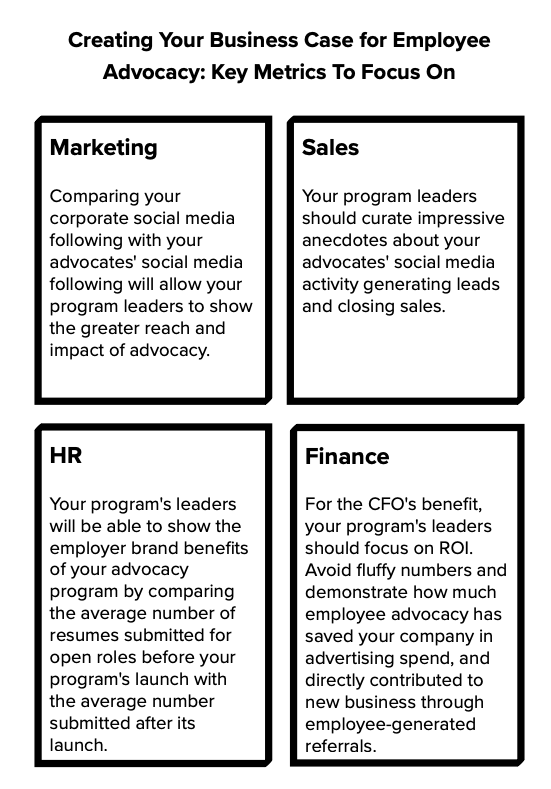
Listen to the podcast episode for tips on building a business case for employee advocacy to get sign-off from your CFO.
Use our ROI Calculator and Reach Calculator to discover the impact that an employee advocacy program can have for your organization.
#96: Keep Building Your Business Case… and Be Ready to Back It.
It’s quite possible that some of your company’s C-level executives won’t fully understand your employee advocacy program’s value, and so won’t be as supportive of it as they should be.
Because of that, it’ll be important for your program’s leaders to be ready and able to demonstrate its cost-effectiveness with hard numbers—especially when it comes to asking for last year’s budget to be matched.
From launch day onwards, your program leaders should invest time in building a multi-aspect business case to prove its value to your C-level Marketing, Sales, HR, and Financial executives.
Their overall goal will be to show that when it comes to building your company’s brand and connecting with both prospective and existing clients, employee advocacy is far and away the most cost-effective method.
Level 8: Career Mode
#99: You’re Not Alone!: Network With Program Leaders From Other Companies.
While advocacy used to be a fringe idea, it’s becoming more mainstream. These days, you’ll see people adding “Employee Advocacy Program Manager” to their LinkedIn bios or work experience.
Following and networking with other program leaders will further your understanding of the employee advocacy and employer branding space overall, as well as spark content and strategy ideas.
Don’t be afraid to reach out to them and have a conversation. As long as they’re not direct competitors, most employee advocacy program managers will be down to share their insights.
Take a look at the content their advocates are sharing.
Knowing what other companies are doing well, and what might not be working will help you manage your own advocacy program.
You don’t need to reinvent the wheel when it comes to building your strategy.
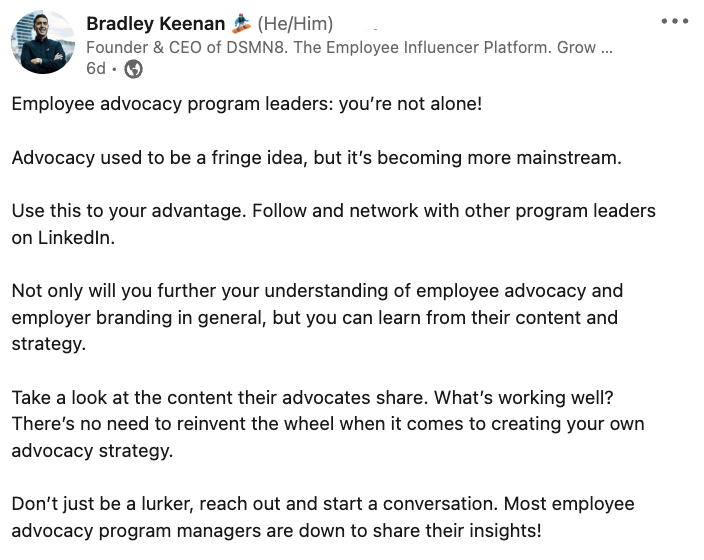
Discover More Employee Advocacy Cheat Codes
Employee Advocacy: 101 Cheat Codes by Bradley Keenan is now available to purchase on Amazon, in paperback and Kindle formats.
If you prefer to listen, an audiobook version narrated by Bradley is available on Audible and Spotify.
We do also have a number of free copies available for those looking to improve their employee advocacy efforts. If you want to get your hands on one, register your interest below!
Register Your Interest 👇
Ready to Take Your Employer Branding and Advocacy Efforts to the Next Level?
Book a demo of DSMN8, the #1 Employee Advocacy Solution.



